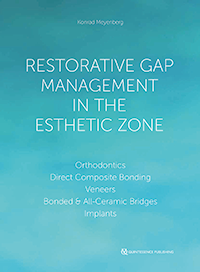Restorative Gap Management in the Esthetic Zone
Orthodontics | Direct Composite Bonding | Veneers | Bonded & All-Ceramic Bridges | Implants
1st Edition 2023
Libro
Hardcover; 21 x 28 cm, 176 pagine, 525 foto
Lingua: Inglese
Argomenti: Odontoiatria estetica, Protesi, Odontoiatria restaurativa, Implantologia, Ortodonzia
ISBN 978-1-78698-130-1
QP Deutschland
Acquista questo prodotto presso i seguenti editori:
Acquista presso QP Deutschland Acquista presso QP United Kingdom Acquista presso QP USA Acquista presso QP Australia+New Zealand
Questo titolo è disponibile anche in formato eBook. Cercalo e scaricalo sul tuo dispositivo che normalmente utilizzi per leggere i libri e le riviste in formato elettronico (Apple iBooks, Amazon Kindle e molti altri).
Today, adhesive techniques for partial crowns and bridges have become routine protocol, complementing established treatment options for fixed prosthodontics. Minimally invasive or noninvasive treatment options such as direct bonding with composite, veneers or resin-bonded bridges greatly help to reduce esthetic, technical, and biologic complications and increase the potential for reintervention. Therefore, these alternatives to anterior implants have gained increasing importance. Consequently, this book covers a wide spectrum of therapeutic means to deal with gaps in the anterior region. The content is divided into the following sub-themes: moving (the orthodontic approach), bonding (the restorative, noninvasive approach), placing pontics (the reconstructive approach with bonded or full-crown bridges), and placing implants (the implantologic approach).
The book is based on long-term clinical experience, with cases that are precisely described and richly documented with full-colour images. It is not a literature review but rather a type of atlas that presents its practical and knowledgeable content in the context of the relevant literature. It can therefore be regarded as an inspiring recipe book for clinical success.
Contents
Chapter 1. Some general considerations
Chapter 2. Restorative space management – a multidisciplinary approach
- Restorative or reconstructive corrections with or without preceding orthodontic treatment?
Chapter 3. Restorative and reconstructive options
Chapter 4. Case presentations and some technical considerations
- Gap closure and substitution of missing teeth
- Gap opening and tooth replacement
- Adhesive bridges
- Conventional bridges
- Implants
- Gap distribution and restorative compensation
- Gap shifting and restorative compensation
- Gap compensation exclusively by reconstructive means
Chapter 5. Final remarks





